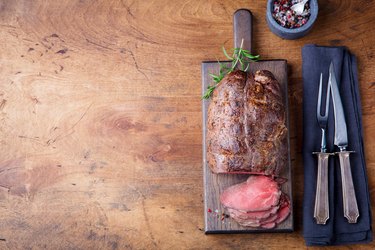
When cold weather hits and your desire to go outside and make your dinner on the grill wanes, it's time to start thinking about some delicious, low-maintenance meals to make indoors. Cross rib roast is a great option for meat lovers, as it's super tender, scrumptious and easy to make.
Tip
To cook a cross-cut rib roast indoors, season your meat and set it in an uncovered roasting pan. Cook on 350 degrees Fahrenheit for approximately 25 minutes per pound of meat. Make sure the internal temperature reaches at least 145 F before serving.
Video of the Day
Bread and Butter Roast
Sometimes called "bread and butter roast" because it cuts so soft and smooth, cross rib roast surprisingly doesn't come from the rib area of the cow. Rather, a beef rib roast comes from the shoulder of the animal. It's the layers of fat found in this area that make the roast so juicy and flavorful. But be mindful — this area of the meat can also be tough unless it's cooked nice and slow.
Video of the Day
There are essentially two ways to cook cross-cut rib roast indoors. You can cook it in the oven on a low temperature or, if you want, you can even put it in a slow cooker on low all day. Either way, the end result is juicy, melt-in-your mouth deliciousness. And the best part? With the minimal preparation needed to cook a cross rib roast, you can spend more time prepping healthy side dishes or entertaining your guests.
Cross Rib Roast Recipe
This cross rib roast recipe is easy to follow and is always a crowd pleaser.
- Heat your oven to 350 F.
- While your oven is heating, rub a simple mixture of garlic, pepper and thyme all over the roast, pressing firmly.
- Place the rib roast, fat side up, in a roasting pan and stick an oven-proof meat thermometer in the thickest part of your roast. Make sure the thermometer isn't touching bone or fat.
- Place your rib roast in the oven, let it cook until the meat thermometer reaches 135 F and then take it out of the oven.
- Cover the rib roast loosely with aluminum foil and let it rest for 15 to 20 minutes. The roast will continue to heat up this way.
- Using your meat thermometer, make sure the meat has reached a minimum internal temperature of 145 F, as per the USDA Food Safety and Inspection Service (USDA). For a medium-rare roast, aim for 145 F; medium will be closer to 160 F.
- Carve and enjoy!
Tip
The best way to carve your rib roast is to place it on its large end on a cutting board. Stick your carving fork in from the side. Then, holding your knife parallel, slice in toward the bone. Next, cut along the rib bone to release your slice. Slide your knife underneath, lift and plate it.
Nutrition Information and Considerations
According to the USDA, a 3-ounce portion of cross rib roast is approximately 300 calories and 19 grams of protein. It also provides 10 percent of your daily value for iron, which helps support essential biological functions such as oxygen transport and energy production, notes Oregon State University's Linus Pauling Institute. You can also find iron in foods such as spinach, legumes, quinoa, turkey, broccoli and even dark chocolate.
The American Heart Association recommends balancing out your diet by eating an overall regimen that emphasizes a variety of fruits and vegetables, whole grains, low-fat dairy products, skinless poultry and fish, nuts and legumes.
Try supplementing your rib roast with some healthy side dishes to round out your meal — or start with LIVESTRONG.com's fresh, fiber-packed Broccoli Salad or Cucumber Salad recipe as a first course. You can always up your salad game with whole grains and finish with a delicious dessert of mixed berries. Voila, a nutritious and balanced dinner is served!
Read more: A Balanced Diet for Women 50 and Over
- USDA Food Safety and Inspection Service: “Beef From Farm to Table”
- USDA Food Safety and Inspection Service: “Nutrition Facts: Beef and Veal”
- Oregon State University: Linus Pauling Institute: “Iron”
- American Heart Association: “The American Heart Association Diet and Lifestyle Recommendations”
- University of Nebraska-Lincoln: "Oven Roasting Guidelines for Beef"